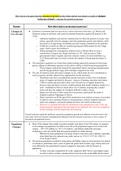How far do you agree that the increase in poverty in the Tudor period was largely a result of changes
in the use of land? - reasons for growth in poverty
Reason How did it lead to an increase in poverty?
Changes in ● Enclosure of common land was seen to be a cause of poverty at the time, e.g. Wolsey and
Use of Land Somerset acting on enclosure, and action by peasants themselves against the practice in the
1530s
○ Ambitious landlords enclosed the common land on which the poorest in society were
reliant, especially after the changes caused by population growth and inflation, while
the practices of engrossing, forestalling and rack-renting contributed to the problem
○ Could have a knock-on effect as common grazing provided manure for the village
crops - hard to grow food without it
○ Wolsey prompted by contemporary thinkers such as Thomas More to issue a
commission of enquiry into illegal enclosures in 1517 and successive Tudor
governments tried to regulate enclosure (clearly a source of social instability) e.g.
1533 Sheep and Farms Act tried to restrict the number of sheep kept per farmer to
2,400
● The transition to pastoral use of land from arable farming reduced the amount of food crops
grown, adding to inflationary pressure on the nation’s ability to feed the growing population
○ These changes reduced the demand for agricultural labour, increasing unemployment
and driving agricultural wages down through competition for work
● The sale of monastic lands often led to changes in use, which made less of a contribution to
local economies and thus offered fewer opportunities for the rural poor.
○ Dissolution may have exacerbated the spread of poverty as they were a traditional
source of support and alms for the poor - sources of learning, education and charity
○ 7,000 ex-monks and nuns had to find a new life and way to support themselves,
however nuns and friars received a smaller pension than monks (ordinary monks £5 a
year) - forbidden by Henry to break their vow of chastity, meaning they couldn’t
marry and have the support of a husband, difficult to make a living
○ Impact was felt most in those areas that were poorest, particularly the north of
England (explains Pilgrimage of Grace)
○ Henry’s promises to fill the gap left by monasteries were broken as money was needed
to fund his wars, meaning schemes to fund preachers, schools, hospitals and poor
relief were dropped - increased hardship for those who relied on them most
○ However it is possible that after the dissolution of the monasteries in the 1530s, the
former monastic land passed into the hands of lay landlords who were less scrupulous
in their dealings with the tenants they had inherited
Overall enclosure made the problems caused by population growth and inflation worse but wasn’t the
root cause, however because contemporaries blamed it for the increase in poverty, it was a source of
discontent and potential unrest.
Population ● Most of the changes from arable to pasture actually took place in the 15th century in response
Changes to the collapse in population; the effects were felt as the population began to rise in the 16th
century - 1525 2.26 million, by 1551 3.01 million - and farmers lacked the necessary
technology to turn less fertile land into ground suitable for arable farming
○ Difficult for food production to increase which in turn led to price inflation, especially
when failed harvests reduced crop yields, such as in 1519-21, 1527-29, 1549-51,
1554-56 and 1586-87
● The growing population resulted in rising prices and falling wages as more pressure was placed
on resources, particularly food - price of grain and goods such as butter, eggs, cheese and wool
were affected as the agricultural economy struggled to keep pace with the increase in
population
○ As there was more competition for work, employers didn’t have to pay higher wages
in order to attract workers, meaning those lower down the social ladder faced serious




